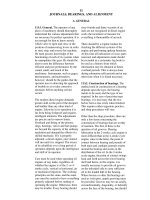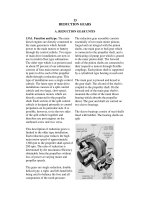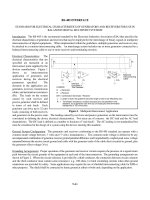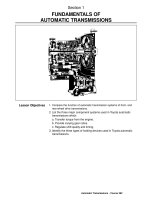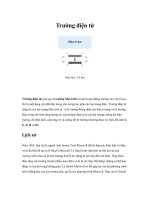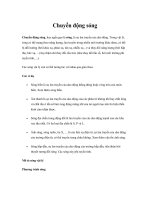Tài liệu Cutting Tools P16 pptx
Bạn đang xem bản rút gọn của tài liệu. Xem và tải ngay bản đầy đủ của tài liệu tại đây (4.98 MB, 7 trang )
www.toolingandproduction.com
Chapter 16/Tooling & Production
1
2
Tooling & Production/Chapter 16
www.toolingandproduction.com
George Schneider, Jr. CMfgE
Professor Emeritus
Engineering Technology
Lawrence Technological University
Former Chairman
Detroit Chapter ONE
Society of Manufacturing Engineers
Former President
International Excutive Board
Society of Carbide & Tool Engineers
Lawrence Tech.- www.ltu.edu
Prentice Hall- www.prenhall.com
CHAPTER 16
Grinding Wheels
and Operations
Metal Removal
Cutting-Tool Materials
Metal Removal Methods
Machinability of Metals
Single Point Machining
Turning Tools and Operations
Turning Methods and Machines
Grooving and Threading
Shaping and Planing
Hole Making Processes
Drills and Drilling Operations
Drilling Methods and Machines
Boring Operations and Machines
Reaming and Tapping
Multi Point Machining
Milling Cutters and Operations
Milling Methods and Machines
Broaches and Broaching
Saws and Sawing
Abrasive Processes
Grinding Wheels and Operations
Grinding Methods and Machines
Lapping and Honing
Upcoming Chapters
16.2 Grinding Wheels
Grinding wheels are composed of
thousands of small abrasive grains held
together by a bonding material. Some
typical grinding products are shown in
Figure 16.2. Each abrasive grain is a
cutting edge. As the grain passes over
the workpiece it cuts a small chip,
leaving a smooth, accurate surface. As
each abrasive grain becomes dull, it
breaks away from the bonding material
because of machining forces and ex-
poses new, sharp grains.
16.2.1 Types of
Abrasives
Two types of abra-
sives are used in grind-
ing wheels: natural and
manufactured. Except
for diamonds, manu-
factured abrasives
have almost totally re-
placed natural abrasive
materials. Even natural
diamonds have been
replaced in some cases
by synthetic diamonds.
The manufactured
abrasives most com-
monly used in grinding
wheels are aluminum
oxide, silicon carbide, cubic boron ni-
tride, and diamond.
Aluminum Oxide: Refining bauxite
ore in an electric furnace makes Alu-
minum oxide. The bauxite ore is first
heated to eliminate any moisture, then
mixed with coke and iron to form a
furnace charge. The mixture is then
fused and cooled. The fused mixture
resembles a rocklike mass. It is
washed, crushed, and screened to sepa-
rate the various grain sizes.
Aluminum oxide wheels are manu-
16.1 Introduction
Grinding, or abrasive machining, is the process of removing metal in the form of
minute chips by the action of irregularly shaped abrasive particles. These
particles may be in bonded wheels, coated belts, or simply loose. The abrasive
grains usually cut with a zero to negative rake angle and produce a large number
of short, small, curly or wavy chips. The way an abrasive grain cuts material is
shown in Fig. 16.1
Negative
rake
Work
Grinding wheel
FIGURE 16.1: Abrasive grains cutting material during a
grinding operation.
www.toolingandproduction.com
Chapter 16/Tooling & Production
3
Chap. 16: Grinding Wheels and OperationsChap. 16: Grinding Wheels and Operations
factured with abrasives of different
degrees of purity to give them certain
characteristics for different grinding
operations and applications. The color
and toughness of the wheel are influ-
enced by the degree of purity.
General purpose aluminum oxide
wheels, usually gray and 95 percent
pure are the most popular abrasives
used. They are used for grinding most
steels and other ferrous alloys. White
aluminum oxide wheels are nearly
pure and are very friable (able to break
away from the bonding material eas-
ily). They are used for grinding high
strength, heat sensitive steels.
Silicon Carbide: Silicon carbide
grinding wheels are made by mixing
pure white quartz, petroleum coke, and
small amounts of sawdust and salt, and
firing the mixture in an
electric furnace. This pro-
cess is called synthesizing
the coke and sand. As in
the making of aluminum
oxide abrasive, the result-
ing crystalline mass is
crushed and graded by
particle size.
Silicon carbide wheels
are harder and more
brittle than aluminum ox-
ide wheels. There are two
principal types of silicon
carbide wheels: black and
green. Black wheels are
used for grinding cast
irons, non-ferrous metals
like copper, brass, alumi-
num, and magnesium, and
nonmetallics such as ce-
ramics and gem stones.
Green silicon carbide wheels are more
friable than the black wheels and used
for tool and cutter grinding of ce-
mented carbide.
Cubic Boron Nitride: Cubic boron
nitride (CBN) is an extremely hard,
sharp, and cool cutting abrasive. It is
one of the newest manufactured abra-
sives and 2 1/2 times harder than alu-
minum oxide. It can withstand tem-
peratures up to 2500 degrees Fahren-
heit. CBN is produced by high tem-
perature, high pressure processes simi-
lar to those used to produce manufac-
tured diamond and is nearly as hard as
diamond.
CBN is used for grinding super hard
high-speed steels, tool and die steels,
hardened cast irons, and stainless steels.
Two types of cubic boron nitride wheels
are used in industry today. One type is
metal coated to promote good bond
adhesion and used in general purpose
grinding. The second type is an un-
coated abrasive for use in electroplated
metal and vitrified bond systems.
Diamond: Two types of diamond are
used in the production of grinding
wheels: natural and manufactured.
Natural diamond is a crystalline form
of carbon and very expensive. In the
form of bonded wheels, natural dia-
monds are used for grinding very hard
materials such as cemented carbides,
marble, granite, and stone.
Recent developments in the produc-
tion of manufactured diamonds have
brought their cost down and led to
expanded use in grinding applications.
Manufactured diamonds are now used
for grinding tough and very hard
steels, cemented carbide, and alumi-
num oxide cutting tools.
The synthetic diamond crystals
shown in Figure 16.3a can be manufac-
tured into polycrystalline tool blanks
shown in Figure 16.3b and discussed in
chapter 1, section 1.5 or pressed into
diamond wheels shown in Figure 16.7.
16.2.2 Types of Bonds
Abrasive grains are held together in
a grinding wheel by a bonding mate-
rial. The bonding material does not cut
during a grinding operation. Its main
function is to hold the grains together
with varying degrees of strength. Stan-
dard grinding wheel bonds are vitri-
fied, resinoid, sillicate, shellac, rubber,
and metal.
Vitrified Bond: Vitrified bonds are
used on more than 75 percent of all
FIGURE 16.2: Typical grinding products. (Courtesy:
Norton Company)
FIGURE 16.3: a) Synthetic diamond crystals; b) Polycrystalline tool blanks (Courtesy: Norton Company)
a. b.
4
Tooling & Production/Chapter 16
www.toolingandproduction.com
Chap. 16: Grinding Wheels and Operations
grinding wheels. Vitrified bond material
is comprised of finely ground clay and
fluxes with which the abrasive is thor-
oughly mixed. The mixture of bonding
agent and abrasive in the form of a wheel
is then heated to 2400 degrees Fahren-
heit to fuse the materials.
Vitrified wheels are strong and
rigid. They retain high strength at el-
evated temperatures and are practically
unaffected by water, oils, or acids. One
disadvantage of vitrified bond wheels
is that they ex-
hibit poor shock
resistance.
Therefore, their
application is
limited where
impact and large
temperature dif-
ferentials occur.
Resinoid
Bond: Resinoid
bonded grinding
wheels are sec-
ond in popular-
ity to vitrified
wheels. Phe-
nolic resin in
powdered or liq-
uid form is
mixed with the
abrasive grains
in a form and
cured at about 360 degrees Fahrenheit.
Resinoid wheels are used for grinding
speeds up to 16,500 SFPM. Their main
use is in rough grinding and cut-off
operations. Care must be taken with
resinoid bonded wheels since they will
soften if they are exposed to water for
extended periods of time.
Silicate Bond: This bonding mate-
rial is used when heat generated by
grinding must be kept to a minimum.
Silicate bonding material releases the
FIGURE 16.4: Comparison of three different grain sizes.
FIGURE 16.5: Comparison of three different grain structures.
FIGURE 16.6: ANSI standard marking system for abrasive grinding wheels. (United abrasives manu-
facturers’ association.)
abrasive grains more readily than other
types of bonding agents. Speed is lim-
ited to below 4500 SFPM.
Shellac Bond: Shellac is an organic
bond used for grinding wheels that
produce very smooth finishes on parts
such as rolls, cutlery, camshafts, and
crankpins. They are not generally used
on heavy duty grinding operations.
Rubber Bond: Rubber bonded
wheels are extremely tough and strong.
Their principal uses are as thin cut-off
wheels and driving wheels in
centerless grinding machines. They are
also used when extremely fine finishes
are required on bearing surfaces.
Metal Bond: Metal bonds are used
primarily as bonding agents for dia-
mond abrasives. They are also used in
electrolytic grinding, where the bond
must be electrically conductive.
16.2.3 Abrasive Grain Size
The size of an abrasive grain is
important because it influences stock
removal rate, chip clearance in the
wheel, and surface finish obtained.
Abrasive grain size is determined by
the size of the screen opening through
which the abrasive grits pass. The num-
ber of the nominal size indicates the
number of the openings per inch in the
screen. For example, a 60 grit-sized
grain will pass through a screen with 55
openings per inch,
but it will not pass
through a screen size
of 65. A low grain
size number indi-
cates large grit, and a
high number indi-
cates a small grain.
Grain sizes vary
from 6 (very coarse)
to 1000 (very fine).
Grain sizes are
broadly defined as
coarse (6 to 24), me-
dium (30 to 60), fine
(70 to 180), and very
fine (220 to 1000).
Figure 16.4 shows a
comparison of three
different grain sizes
and the screens used
for sizing. Very fine
grits are used for pol-
ishing and lapping
operations, fine
grains for fine finish
www.toolingandproduction.com
Chapter 16/Tooling & Production
5
Chap. 16: Grinding Wheels and Operations
and small diameter grinding operations.
Medium grain sizes are used in high
stock removal operations where some
control of surface finish is required.
Coarse grain sizes are used for billet
conditioning and snagging operations
in steel mills and foundries, where
stock removal rates are important, and
there is little concern about surface
finish.
16.2.4 Grinding Wheel Grade
The grade of a grinding wheel is a
measure of the strength of the bonding
material holding the individual grains
in the wheel. It is used to indicate the
relative hardness of a grinding wheel.
Grade or hardness refers to the amount
of bonding material used in the wheel,
not to the hardness of the abrasive. A
soft wheel has less bonding material
than a hard wheel.
The range used to indicate grade is A
to Z, with A representing maximum
softness and Z maximum hardness. The
selection of the proper grade of wheel is
very important. Wheels that are too soft
tend to release grains too rapidly and
wheel wear is great. Wheels that are too
hard do not release the abrasive grains
fast enough and the dull grains remain
bonded to the wheel causing a condition
known as ‘glazing’.
16.2.5 Grinding Wheel Structure
The structure of a grinding wheel
refers to the relative spacing of the
abrasive grains; it is the wheel’s density.
There are fewer abrasive grains in an
open-structure wheel than in a close-
structure wheel. Figure 16.5 shows a
16.3.2 Grinding Wheel Shapes and
Faces
Most grinding wheel manufacturers
have adopted eight standard wheel
shapes and 12 standard wheel faces for
general use. Figure 16.9 shows the most
common standard wheel shapes used on
all types of grinders. Figure 16.10 illus-
trates the standard wheel faces used on
most grinding wheel shapes.
16.4 Electroplated Grinding Wheels
Of the several methods now used
for fixing super abrasive particles of
diamond or CBN to the working sur-
face of an abrasive tool, electroplat-
ing is the fastest growing. More and
more production operations involve
combinations of hard-to-grind materi-
als and complex wheel shapes that
virtually dictate the use of electro-
plated super abrasive tools.
Characteristically, such tools con-
sist of a precision tool form or man-
drel with super abrasive particles de-
posited on the working surface and
locked in place by electrodepositon of
a bonding matrix, most frequently
nickel. The particles so locked onto
the tool surface may vary in size and
dispersion to suit the purpose of the
tool, but they should lie in a single
layer.
Figure 16.11a shows a close-up
view of a electroplated wheel; Figure
16.11b shows various size and shapes
of electroplated wheels.
16.5 Wheel Balancing, Dressing
and Truing
All grinding wheels are breakable,
and some are extremely fragile. Great
care should be taken in handling
grinding wheels. New wheels should
comparison of
different
structures
used in a
grinding
wheel.
A number
from 1 to 15
designates the
structure of a
wheel. The
higher the
number, the
more open
the structure;
the lower the
number, the
more dense
the structure.
16.3 Grinding Wheel Specifications
Grinding wheel manufacturers have
agreed to a standardization system to
describe wheel composition as well as
wheel shapes and faces.
16.3.1 Grinding Wheel Markings
Abrasive grinding wheels have a dif-
ferent marking system than CBN and
diamond wheels as discussed and
shown below.
Abrasive Grinding Wheels: This
marking system is used to describe the
wheel composition as to type of abra-
sive, grain size, grade, structure, and
bond type. Figure 16.6 illustrates this
standard marking system.
CBN and Diamond Wheels: The
same standardization is applicable to
CBN and diamond wheels. Some typi-
cal CBN and diamond wheels are
shown in Figure 16.7. Wheel markings
are a combination of letters and num-
bers as shown in Figure 16.8.
FIGURE 16.7: Typical Cubic Boron Nitride (CBN) and diamond
grinding wheels. (Courtesy Norton Company)
FIGURE 16.8: Standard marking system for Cubic Boron Nitride (CBN) and
diamond grinding wheels.




